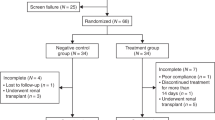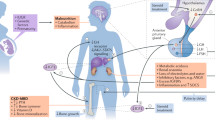Abstract
Growth retardation frequently accompanies chronic kidney disease in children. Unfortunately, this retardation persists in magnitude despite assiduous therapeutic efforts, adequate dialytic intervention, and successful transplantation. The age of the patient at transplantation, allograft function, and corticosteroid dosage are the major factors that contribute to persistent suboptimal growth following renal transplantation. Recent data indicate that the use of recombinant human growth hormone might efficaciously improve growth velocity in the persistently growth-retarded allograft recipient. Attainment of optimum final adult height is predicated on optimum height at the time of transplantation, persistent optimum allograft function, minimization or avoidance of corticosteroid treatment, and, possibly, use of recombinant human growth hormone, especially to potentially maximize the pubertal growth spurt.
Key Points
-
Retardation of growth is a consequence of pediatric chronic kidney disease that is not universally overcome by dialysis or transplantation
-
Factors that affect post-transplantation growth include age at time of transplantation, allograft function, and use of corticosteroids
-
Randomized controlled trials indicate that recombinant human growth hormone is a well tolerated and effective treatment for post-transplantation growth retardation
-
Approval of recombinant human growth hormone for this indication has not been sought from the US FDA or European regulatory bodies
This is a preview of subscription content, access via your institution
Access options
Subscribe to this journal
Receive 12 print issues and online access
$209.00 per year
only $17.42 per issue
Buy this article
- Purchase on Springer Link
- Instant access to full article PDF
Prices may be subject to local taxes which are calculated during checkout




Similar content being viewed by others
References
Tonshoff B and Fine RN (2005) Growth and growth hormone treatment in children with chronic renal insufficiency. In Clinical Dialysis, 611–651 (Ed Nissenson AR) New York: McGraw-Hill
[No authors listed] (online 8 December 2006) NAPRTCS Online [https://web.emmes.com/study/ped/index.htm] (accessed 27 February 2007)
Hutchings RH et al. (1966) Chronic hemodialysis in a pre-adolescent. Pediatrics 37: 68–73
Berard E et al. (1998) Recombinant human growth hormone treatment of children on hemodialysis (French Society of Pediatric Nephrology). Pediatr Nephrol 12: 304–310
Riley CM (1964) Thoughts about kidney hemotransplantation in children. J Pediatr 65: 797
Schaefer F et al. (1990) Pubertal growth in chronic renal failure. Pediatr Res 28: 5–10
van Diemen-Steenvoorde R et al. (1987) Growth and sexual maturation in children after kidney transplantation. J Pediatr 110: 351–356
Ingelfinger JR et al. (1981) Growth acceleration following renal transplantation in children less than 7 years of age. Pediatrics 68: 255–259
Grushkin CM and Fine RN (1973) Growth in children following renal transplantation. Am J Dis Child 125: 514–516
Nissel R et al. (2004) Effect of renal transplantation in childhood on longitudinal growth and adult height. Kidney Int 66: 792–800
Tejani A et al. (1993) Factors predictive of sustained growth in children after renal transplantation. J Pediatr 122: 397–402
Fine RN et al. (1968) Extended hemodialysis in children with chronic renal failure. J Pediatr 73: 706–713
Fine RN et al. (1970) Renal homotransplantation in children. J Pediatr 76: 347–357
Potter DE et al. (1975) Alternate-day steroids in children after renal transplantation. Transplant Proc 7: 79–82
Broyer M et al. (1992) Growth rate in children receiving alternate-day corticosteroid treatment after kidney transplantation. J Pediatr 120: 721–725
Jabs K et al. (1996) Alternate-day steroid dosing improves growth without adversely affecting graft survival or long-term graft function: a report of the North American Pediatric Renal Transplant Cooperative Study. Transplantation 61: 31–36
Klare B et al. (1991) Remarkable long-term prognosis and excellent growth in kidney-transplant children under cyclosporin monotherapy. Transplant Proc 23: 1013–1017
Reisman L et al. (1990) Follow-up of cyclosporin-treated pediatric renal allograft recipients after cessation of prednisone. Transplantation 49: 76–80
Chakrabarti P et al. (2000) Outcome after steroid withdrawal in pediatric renal transplant patients receiving tacrolimus-based immunosuppression. Transplantation 70: 760–764
Benfield MR et al. (2005) A randomized controlled double-blind trial of steroid withdrawal in pediatric renal transplantation: a study of the Cooperative Clinical Trials in Pediatric Transplantation (CCTPT). Presented at the American Transplant Congress: 2005 May 21–25, Seattle, WA
Sarwal MM et al. (2001) Promising early outcomes with a novel, complete steroid avoidance immunosuppression protocol in pediatric renal transplantation. Transplantation 72: 13–21
Sarwal MM et al. (2003) Continued superior outcomes with modification and lengthened follow-up of a steroid-avoidance pilot with extended daclizumab induction in pediatric renal transplantation. Transplantation 76: 1331–1339
Fine RN et al. (1994) Growth after recombinant human growth hormone treatment in children with chronic renal failure: report of a multicenter randomized double-blind placebo-controlled study (Genentech Cooperative Study Group). J Pediatr 124: 374–382
Tonshoff B and Mehls O (1994) Use of rhGH post transplant in children. In Pediatric Renal Transplantation, 441–459 (Ed Tejani AH) New York: Wiley
Bartosh S et al. (1992) Effects of growth hormone administration in pediatric renal allograft recipients. Pediatr Nephrol 6: 68–73
Chavers BM et al. (1996) Effects of growth hormone treatment. Transplantation 61: 893–903
Dharnidharka VR et al. (2004) Hodgkin's lymphoma after post-transplant lymphoproliferative disease in a renal transplant recipient. Pediatr Transplant 8: 87–90
Hokken-Koelega A et al. (1996) A placebo-controlled, double-blind trial of growth hormone treatment in prepubertal children after renal transplantation. Kidney Int 6 (Suppl): S128–S134
Maxwell H and Rees L (1998) Randomized controlled trial of recombinant human growth hormone in prepubertal and pubertal renal transplant recipients. Arch Dis Child 79: 481–487
Guest G et al. (1998) Effects of growth hormone in short children after renal transplantation (French Society of Pediatric Nephrology). Pediatr Nephrol 12: 437–446
Fine RN et al. (2002) Recombinant human growth hormone post-renal transplantation in children: a randomized controlled study of the NAPRTCS. Kidney Int 62: 688–696
Tyden G et al. (2000) Development of renal cell carcinoma in living donor kidney grafts. Transplantation 70: 1650–1656
Mehls O et al. (2002) Does growth hormone treatment affect the risk of post-transplant renal cancer? Pediatr Nephrol 17: 984–989
Dharnidharka VR et al. (2006) Recombinant human growth hormone (rhGH) use pre-transplant and risk of lymphoproliferative disease (LPD) post-transplant [abstract #100]. Presented at the World Transplant Congress: 2006 July 22–27, Boston, MA
Schaefer F et al. (1989) Pubertal growth and final height in chronic renal failure. In Growth and Endocrine Changes in Children and Adolescents with Chronic Renal Failure, 359–371 (Ed Schärer K) Basel: Karger
Hokken-Koelega AC et al. (1994) Final height and its predictive factors after renal transplantation in childhood. Pediatr Res 36: 323–328
Hokken-Koelega AC et al. (1994) Growth hormone treatment in growth-retarded adolescents after renal transplantation. Lancet 343: 1313–1317
Morel P et al. (1991) Long-term quality of life after kidney transplantation in childhood. Transplantation 52: 47–53
Acknowledgements
Désirée Lie, University of California, CA, is the author of and is solely responsible for the content of the learning objectives, questions and answers of the Medscape-accredited continuing medical education activity associated with this article.
Author information
Authors and Affiliations
Ethics declarations
Competing interests
The author declares no competing financial interests.
Rights and permissions
About this article
Cite this article
Fine, R. Management of growth retardation in pediatric recipients of renal allografts. Nat Rev Nephrol 3, 318–324 (2007). https://doi.org/10.1038/ncpneph0502
Received:
Accepted:
Issue Date:
DOI: https://doi.org/10.1038/ncpneph0502
This article is cited by
-
Near-adult height in male kidney transplant recipients started on growth hormone treatment in late puberty
Pediatric Nephrology (2018)
-
The Renal Transplant Patient—Updates for the Pediatrician
Current Treatment Options in Pediatrics (2016)
-
Final adult height in kidney recipients who underwent highly successful transplantation as children: a single-center experience
Clinical and Experimental Nephrology (2014)



